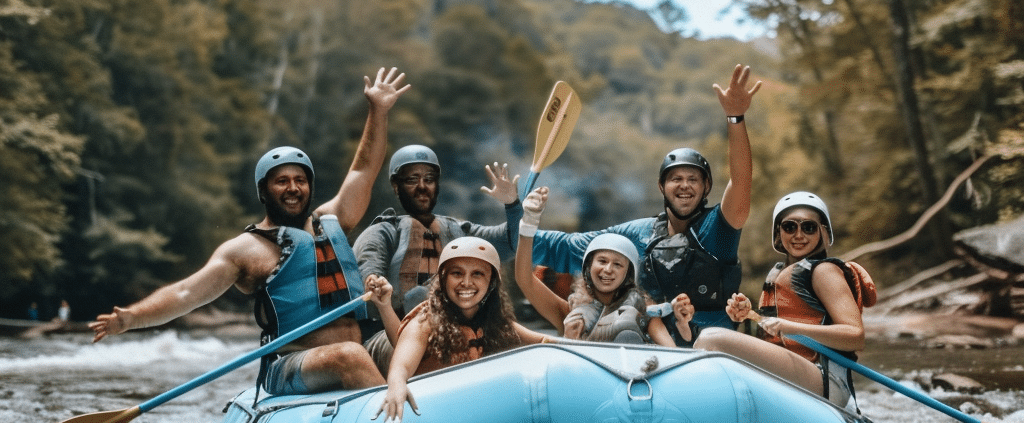Is white water rafting on the Ocoee safe
White water rafting on the Ocoee River is often viewed as the hidden gem of outdoor adventures, overshadowed by more mainstream activities like hiking or mountain biking. Yet, it carves its niche with an invigorating mix of adrenaline and natural beauty. This unique blend sets it apart in the realm of outdoor sports, offering a distinct experience that marks Ocoee River rafting as an adventure in its own league.
Key aspects of Ocoee River rafting include navigating through Class III and IV rapids, the camaraderie of team paddling, and the serene moments amidst the Tennessee wilderness. Each of these elements contributes to the allure of Ocoee River rafting, making it a sought-after experience for thrill-seekers and nature enthusiasts alike. Diving deeper, each aspect of rafting on the Ocoee River—from the rush of conquering challenging rapids to the tranquility of floating down serene river stretches—presents its own set of thrills, skills required, environmental significance, and recommendations for a successful trip.
The following sections will explore these facets in detail, providing a comprehensive view of what makes rafting on the Ocoee River a beloved adventure for many.
What is White Water Rafting?
White water rafting is an exhilarating outdoor activity that involves navigating a raft through various sections of a river, where the water flows rapidly over rocks and through tight channels, creating what are known as rapids. These rapids are classified based on their difficulty, ranging from Class I (easy) to Class VI (extreme danger), with the Ocoee River offering an exciting mix of Class III and IV rapids. This classification system helps rafters understand the challenges they might face on the water.
The adventure combines teamwork, as participants paddle together to steer and propel the raft, with the thrill of battling the river’s power. It’s not just about the adrenaline rush, though; white water rafting also allows individuals to connect with nature, offering moments of tranquility amidst the invigorating rapids. Safety is a top priority, with guides providing instruction and protective gear to ensure an enjoyable experience for everyone.
Ocoee River’s Popularity for Rafting
The Ocoee River, nestled in the scenic landscapes of Tennessee, has cemented its status as a premier destination for white water rafting enthusiasts. Its popularity stems from the exhilarating Class III and IV rapids that challenge both novice and experienced rafters alike. These rapids offer a thrilling ride through waves, drops, and tight passages that demand teamwork and paddling prowess.
Beyond the adrenaline-inducing rapids, the Ocoee River is surrounded by breathtaking natural beauty, enhancing the rafting experience with stunning views of lush forests and wildlife. The river’s fame was further boosted when it served as the venue for the canoe slalom events during the 1996 Atlanta Olympics, showcasing its world-class rapids to a global audience. This blend of challenging rapids and natural splendor, combined with a rich historical backdrop, makes the Ocoee River a bucket-list adventure for those seeking to immerse themselves in the thrill of white water rafting.
Challenging Class III and IV rapids
The Ocoee River is renowned for its Class III and IV rapids, which present a thrilling challenge to rafters. Class III rapids, known as moderate, require precise maneuvering and teamwork to navigate through irregular waves and strong currents. On the other hand, Class IV rapids, considered advanced, demand high levels of skill and courage, as rafters face intense, powerful waves and tight passages that test their paddling strength and agility.
These rapids make the Ocoee River an ideal playground for adventure seekers looking to push their limits and experience the exhilaration of conquering nature’s formidable obstacles.
Safety Management on the Ocoee
Ensuring safety on the Ocoee River is paramount, with a comprehensive approach that includes experienced guides, state-of-the-art safety equipment, and thorough pre-rafting safety briefings. Guides on the Ocoee are not only skilled in navigating the river’s challenging rapids but are also trained in rescue techniques and first aid, ready to respond to any situation. Rafters are equipped with essential safety gear, such as helmets and life jackets, which are mandatory for all participants, regardless of their swimming abilities.
Additional equipment like throw ropes and rescue bags are always on hand for emergency situations. Before setting off, every rafter undergoes a safety briefing, covering the basics of rafting, how to handle unexpected swims, and teamwork strategies. This multi-layered safety strategy ensures that the thrill of rafting the Ocoee comes with a strong foundation of security and preparedness.
Experienced Guides’ Qualifications
Experienced guides on the Ocoee River are not just adept at steering rafts through turbulent waters; they hold certifications in first aid and swift water rescue. Their expertise ensures not only an exciting journey but also a safe one, as they can swiftly manage any challenges that arise on the river.
Types of Safety Equipment
Safety on the river is reinforced with state-of-the-art equipment. This includes personal protective gear and tools designed for swift water rescue, ensuring that every rafter is well-equipped to face the rapids with confidence.
Helmets and Life Jackets
Helmets and life jackets are non-negotiable for anyone venturing onto the Ocoee River. These critical pieces of safety gear protect against head injuries and keep rafters afloat in the water, significantly reducing the risk of drowning.
Throw Ropes and Rescue Bags
In the event of a capsize or a rafter falling overboard, throw ropes and rescue bags are vital. They allow guides and rafters to quickly pull someone back to safety, demonstrating the importance of having reliable rescue tools on hand during every trip.
Pre-Rafting Safety Briefings
Before embarking on their adventure, all participants receive comprehensive pre-rafting safety briefings. These sessions cover essential topics such as how to properly sit in the raft, paddle effectively, and what to do if you find yourself in the water unexpectedly. This preparation is key to ensuring that everyone enjoys a thrilling yet secure rafting experience.
Risks of Rafting on the Ocoee
Rafting on the Ocoee River, while exhilarating, comes with inherent risks associated with navigating its Class III and IV rapids. Understanding these risks is crucial for a safe rafting experience. Rapid classifications indicate the level of difficulty and potential danger, with the Ocoee’s moderate to advanced rapids requiring skillful navigation to avoid mishaps.
Water levels and flow rates can significantly affect the river’s intensity, with higher volumes leading to more powerful and unpredictable rapids. Weather conditions also play a critical role, as sudden changes can alter the rafting dynamics and increase the challenge. Moreover, rafters must assess their physical condition, as the demanding nature of the activity requires good health, stamina, and swimming ability.
By acknowledging these risks and preparing accordingly, rafters can enhance their safety and enjoyment on the Ocoee River.
Understanding Rapid Classifications
Rapid classifications on the Ocoee River range from Class III to IV, serving as a guide to the challenges and risks rafters may encounter. These classifications help rafters gauge the difficulty level and prepare for the adventure ahead.
Class III: Moderate
Class III rapids are characterized by moderate waves and obstacles that can be managed with basic rafting skills. They require teamwork and the ability to follow the guide’s instructions to successfully navigate.
Class IV: Advanced
Class IV rapids present a more formidable challenge with powerful waves, tight turns, and the potential for large obstacles. These rapids demand a higher level of skill, quick decision-making, and a strong sense of adventure.
Water Levels and Flow Rates
The water levels and flow rates of the Ocoee River greatly influence the rafting experience. Higher water levels can intensify rapids, making them more unpredictable and challenging, requiring extra caution and respect for the river’s power.
Weather Conditions
Weather conditions can affect rafting safety and enjoyment. Sudden weather changes can alter water levels and visibility, making it crucial for rafters to be prepared and for guides to make informed decisions about proceeding.
Inadequate Physical Condition
An inadequate physical condition can increase the risk of injury or exhaustion on the river. It’s important for participants to assess their fitness and swimming ability, as well as to communicate any concerns to their guide before embarking on the rafting adventure.
Preparing for a Safe Rafting Experience
A safe rafting experience on the Ocoee River begins with thorough preparation, encompassing physical fitness, understanding rafting basics, and selecting appropriate gear. Ensuring you are in good physical shape is crucial, as rafting demands stamina, strength, and the ability to swim. Familiarizing yourself with rafting techniques and safety protocols, such as how to maneuver through rapids and what to do if you fall out of the raft, enhances your readiness for the adventure.
Equally important is choosing the right gear, including water shoes or sneakers for secure footing and synthetic or wool clothing layers for warmth and protection. This preparatory phase is not just about physical readiness but also about mental preparation, setting the stage for a thrilling yet secure journey down the Ocoee River.
Physical Fitness Requirements
Physical fitness is essential for tackling the Ocoee River’s rapids. Rafters should have good stamina, strength, and be comfortable swimming in moving water. This foundation ensures you can enjoy the adventure while minimizing the risk of injury.
Understanding Rafting Basics
Understanding rafting basics is key to a successful trip. This includes knowing how to paddle effectively, how to position yourself in the raft, and the actions to take if you unexpectedly enter the water. Familiarity with these basics enhances safety and enjoyment.
Selecting Appropriate Gear
Choosing the right gear is critical for comfort and safety on the river. This gear includes personal flotation devices (PFDs), helmets, and appropriate clothing that can withstand the river’s challenges.
Water Shoes or Sneakers
Water shoes or sneakers are recommended for their grip and protection. They help secure your footing in the raft and on the riverbank, reducing the risk of slips or foot injuries.
Synthetic or Wool Clothing Layers
Wearing synthetic or wool clothing layers helps maintain body temperature in the cool river water. These materials keep you warm even when wet, unlike cotton, which can chill the body and increase the risk of hypothermia.




Leave a Reply
Want to join the discussion?Feel free to contribute!